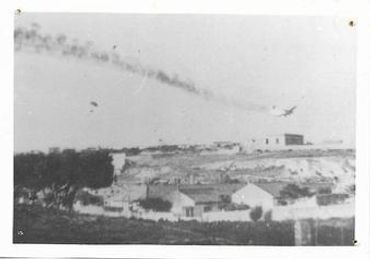battalion history
The 2/4th Australian Infantry Battalion's first drafts of recruits arrived at Ingleburn Camp on 3 November 1939. Part of the 16th Brigade of the 6th Australian Division, the battalion departed Sydney for service overseas on 10 January 1940. The 2/4th Battalion was eventually transferred to the 19th Brigade, but remained part of the 6th Division.
Arriving in the Middle East on 14 February 1940, the 2/4th Battalion trained in Palestine and Egypt in preparation for its first campaign, which was against the Italians in eastern Libya. The Battalion played a role at Bardia (3-5 January 1941) and the Battle for Tobruk (21-22 January 1941), and had to fight particularly hard to secure the Wadi Derna (26-30 January). It was the first Australian unit to enter Benghazi, on 6 February, and subsequently garrisoned the town until 22 February.
In early April 1941, the 2/4th Battalion, with the rest of the 6th Division, deployed to Greece to resist the anticipated German invasion. It fought a fierce battle at Vevi in northern Greece on 11-12 April 1941 and then withdrew through a series of rearguard positions until evacuated, by sea, from Megara on 26 April 1941. The Battalion landed on Crete the next day and eventually joined the force defending Heraklion Airfield. When German paratroops landed on 20 May 1941 they were rapidly overcome in the area immediately around the airfield. The paratroops were, however, able to gain a foothold outside the defended area. This, combined with German successes elsewhere on Crete, brought about the evacuation of Heraklion by sea on 29 May.
After a period of training in Palestine, the 2/4th Battalion joined the force garrisoning Syria. It completed this duty in mid-January 1942, embarked for home on 12 February 1942, and arrived at Adelaide on 27 March 1942. In June 1942, the 19th Brigade was deployed to defend Darwin and the 2/4th Battalion remained there for a year. The Brigade rejoined the rest of the 6th Division training in northern Queensland in June 1943.
The 2/4th Battalion landed at Aitape in New Guinea on 2 November 1944 to undertake its only campaign against the Japanese. Its most intense effort took place between April and July 1945. Landed at But, the battalion advanced along the coast, captured Wewak on 10 May 1945, and then swung inland to clear the foothills of the Prince Alexander Range. For his actions during the attack on Wirui Mission on 14 May 1945, Private Edward Kenna was awarded the Victoria Cross.
Following the Japanese surrender on 15 August 1945, drafts of 2/4th Battalion men began returning to Australia for discharge. The remainder of the battalion itself arrived home on 26 October 1945 and disbanded at Chermside in Queensland on 12 November 1945.
The Commanding Officers of the 2/4th Australian Infantry Battalion were the following:-
Lieutenant-Colonel Percival Parsons (1939–40)
Lieutenant-Colonel Ivan Dougherty (1940–42)
Lieutenant-Colonel Nevis Farrell (1942–45)
Lieutenant-Colonel Geoffrey Cox (1945)
Lieutenant Colonel (later Major-General Sir) Ivan Dougherty went on to become the long-time Patron of the 2/4th Australian Infantry Battalion Association.
sources
Brief History of the 2/4th Australian Infantry Battalion – drawn from White over Green: the 2/4th Battalion and reference to the 4th Battalion, (Sydney: Angus & Robertson in association with 2/4th Infantry Battalion Association, 1963) and courtesy of the Australian War Memorial.
Photo Gallery















